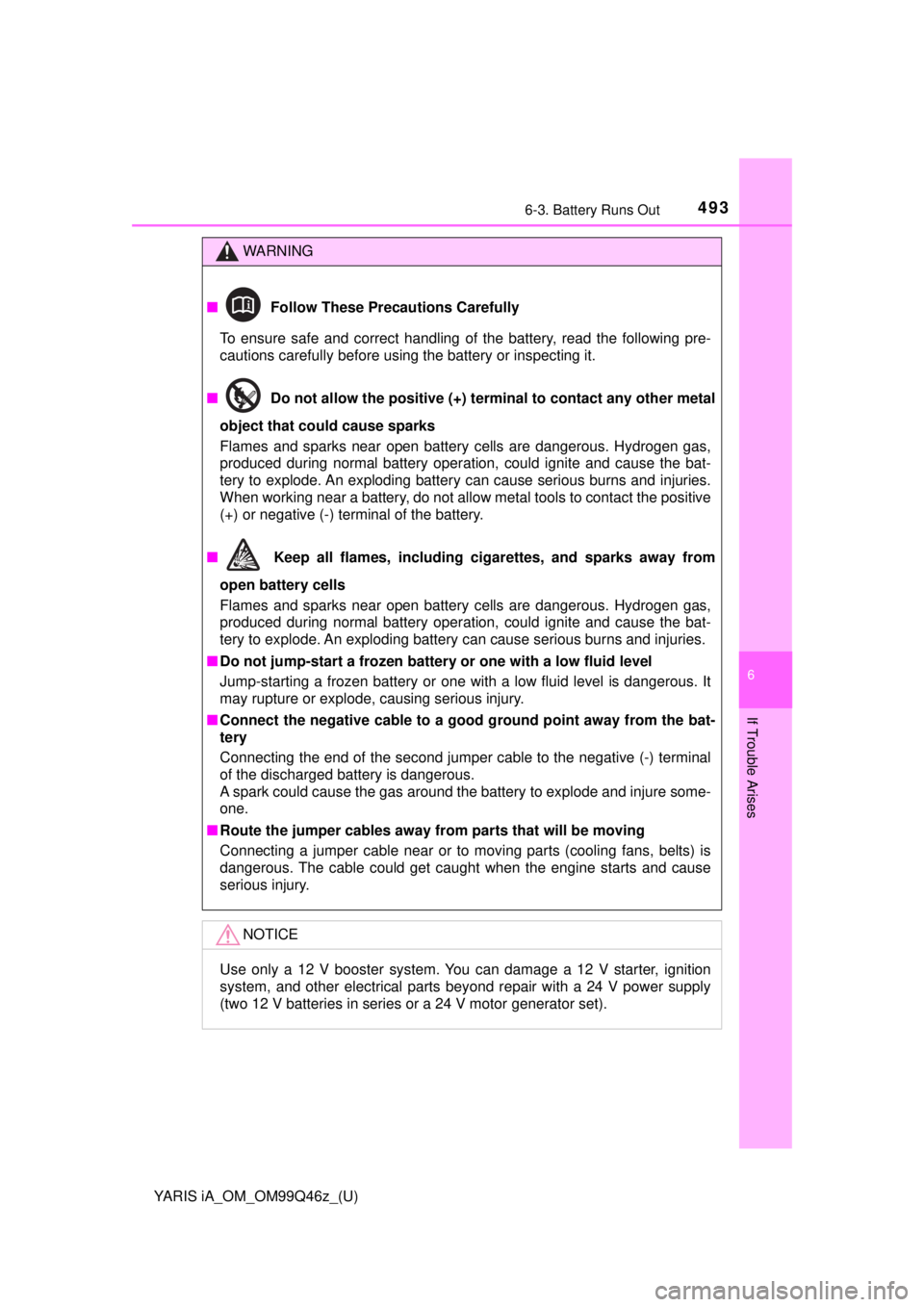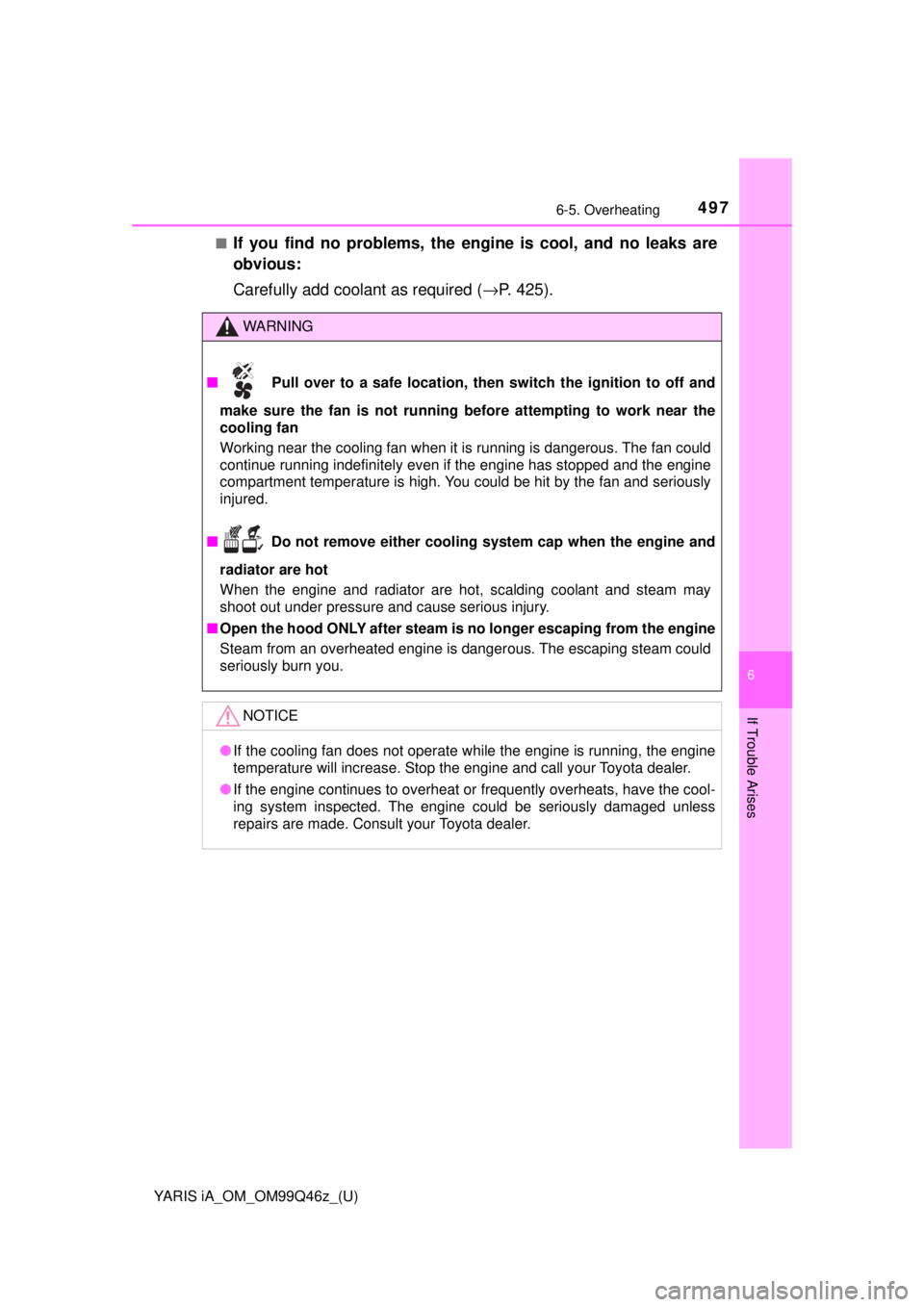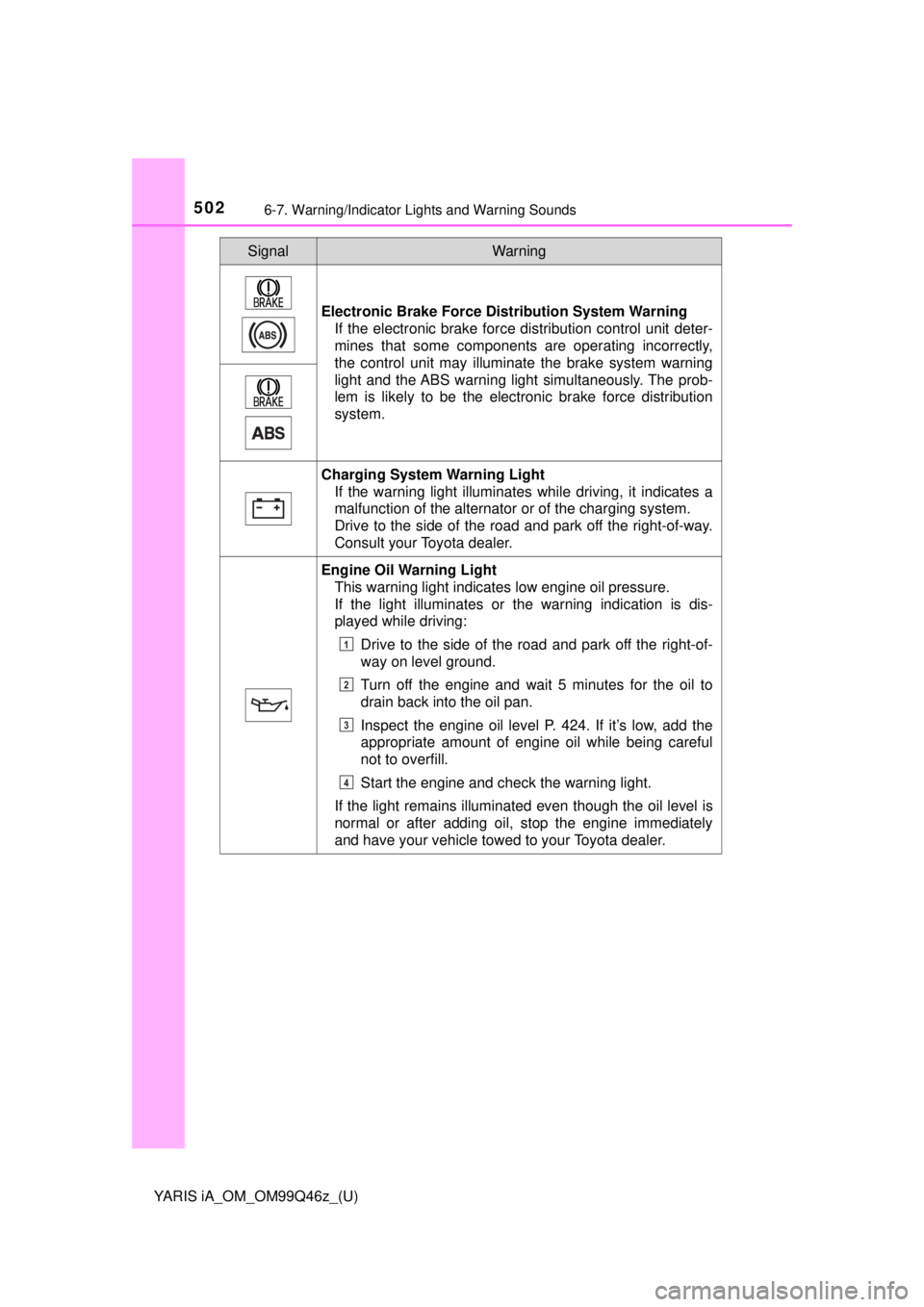Page 491 of 576
491
YARIS iA_OM_OM99Q46z_(U)
6-3. Battery Runs Out
6
If Trouble Arises
Jump-Starting
Jump-starting is dangerous if done incorrectly. So follow the proce-
dure carefully. If you feel unsure about jump-starting, we strongly rec-
ommend that you have a competent service technician do the work.Remove the battery cover.
Make sure the booster battery is 12 V and that its negative terminal
is grounded.
If the booster battery is in another vehicle, do not allow both vehi-
cles to touch. Turn off the engine of the vehicle with the booster bat-
tery and all unnecessary electrical loads in both vehicles.
1
2
3
Page 492 of 576
4926-3. Battery Runs Out
YARIS iA_OM_OM99Q46z_(U)
Connect the jumper cables in the exact sequence as in the illustra-
tion.
Connect one end of a cable to the positive terminal on the dis-
charged battery.
Attach the other end to the positive terminal on the booster bat-
tery.
Connect one end of the other cabl e to the negative terminal of
the booster battery.
Connect the other end to the ground point indicated in the illus-
tration away from the discharged battery.
Start the engine of the booster v ehicle and run it a few minutes.
Then start the engine of the other vehicle.
When finished, carefully disconnect the cables in the reverse order
described in the illustration.
If the battery cover has been removed, install it in the reverse order
of removal.
Verify that the covers are securely installed.
4
Jumper cables
Booster battery
Discharged battery
1
2
3
4
5
6
7
Page 493 of 576

YARIS iA_OM_OM99Q46z_(U)
4936-3. Battery Runs Out
6
If Trouble Arises
WARNING
■ Follow These Precautions Carefully
To ensure safe and correct handling of the battery, read the following pre-
cautions carefully before using the battery or inspecting it.
■ Do not allow the positive (+) term inal to contact any other metal
object that could cause sparks
Flames and sparks near open battery cells are dangerous. Hydrogen gas,
produced during normal battery operation, could ignite and cause the bat-
tery to explode. An exploding battery can cause serious burns and injuries.
When working near a battery, do not allow metal tools to contact the positive
(+) or negative (-) terminal of the battery.
■ Keep all flames, including cigarettes, and sparks away from
open battery cells
Flames and sparks near open battery cells are dangerous. Hydrogen gas,
produced during normal battery operation, could ignite and cause the bat-
tery to explode. An exploding battery can cause serious burns and injuries.
■ Do not jump-start a frozen battery or one with a low fluid level
Jump-starting a frozen battery or one with a low fluid level is dangerous. It
may rupture or explode, causing serious injury.
■ Connect the negative cable to a good ground point away from the bat-
tery
Connecting the end of the second jumper cable to the negative (-) terminal
of the discharged battery is dangerous.
A spark could cause the gas around the battery to explode and injure some-
one.
■ Route the jumper cables away fr om parts that will be moving
Connecting a jumper cable near or to moving parts (cooling fans, belts) is
dangerous. The cable could get caught when the engine starts and cause
serious injury.
NOTICE
Use only a 12 V booster system. You can damage a 12 V starter, ignition
system, and other electrical parts beyond repair with a 24 V power supply
(two 12 V batteries in series or a 24 V motor generator set).
Page 494 of 576
494
YARIS iA_OM_OM99Q46z_(U)
6-4. Emergency Starting
Starting a Flooded Engine
Follow this procedure:If the engine does not start within five seconds on the first try, wait
ten seconds and try again.
Make sure the parking brake is on.
Depress the accelerator all the way and hold it there.
Depress the clutch pedal (Manual transaxle) or the brake pedal
(Automatic transaxle), then pres s the push button start. If the
engine starts, release the accele rator immediately because the
engine will suddenly rev up.
If the engine fails to start, crank it without depressing the accelera-
tor.
If the engine still does not start using the above procedure, have your
vehicle inspected by your Toyota dealer.
If the engine fails to start, it may be flooded (excessive fuel in
the engine).
1
2
3
4
5
Page 495 of 576
495
YARIS iA_OM_OM99Q46z_(U)
6-4. Emergency Starting
6
If Trouble Arises
Push-Starting
Do not push-start your Toyota.
You cannot start a vehicle with an automatic transaxle by pushing it.
WARNING
■Never tow a vehicle to start it
Towing a vehicle to start it is dangerous. The vehicle being towed could
surge forward when its engine starts, causing the two vehicles to collide.
The occupants could be injured.
NOTICE
Do not push-start a vehicle that has a manual transaxle. It can damage the
emission control system.
Page 496 of 576

496
YARIS iA_OM_OM99Q46z_(U)
6-5. Overheating
Overheating
If the high engine coolant temperature warning light turns on:Drive safely to the side of the road and park off the right-of-way.
Put a vehicle with an automatic tr ansaxle in park (P), a manual tran-
saxle in neutral.
Apply the parking brake.
Turn off the air conditioner.
Check whether coolant or steam is escaping from the engine com-
partment.
If steam is coming from the engine compartment
Do not go near the front of the vehicle. Stop the engine.
Wait until the steam dissipates, then open the hood and start the
engine.
If neither coolant nor steam is escaping
Open the hood and idle the engine until it cools.
Make sure the cooling fan is operating, then turn off the engine after
the temperature has decreased.
When cool, check the coolant level.
If it is low, look for coolant leaks from the radiator and hoses.
■If you find a leak or other damage , or if coolant is still leaking:
Stop the engine and call your Toyota dealer.
Cooling fan
Cooling system cap
Coolant reservoir
If the high engine coolant temperature warning light turns on,
the vehicle loses power, or you hear a loud knocking or pinging
noise, the engine is probably too hot.
1
2
3
4
5
6
7
1
2
3
Page 497 of 576

YARIS iA_OM_OM99Q46z_(U)
4976-5. Overheating
6
If Trouble Arises
■If you find no problems, the engine is cool, and no leaks are
obvious:
Carefully add coolant as required (→P. 425).
WARNING
■ Pull over to a safe location, then switch the ignition to off and
make sure the fan is not running befo re attempting to work near the
cooling fan
Working near the cooling fan when it is running is dangerous. The fan could
continue running indefinitely even if the engine has stopped and the engine
compartment temperature is high. You could be hit by the fan and seriously
injured.
■ Do not remove either cooling system cap when the engine and
radiator are hot
When the engine and radiator are hot, scalding coolant and steam may
shoot out under pressure and cause serious injury.
■ Open the hood ONLY after steam is no longer escaping from the engine
Steam from an overheated engine is dangerous. The escaping steam could
seriously burn you.
NOTICE
● If the cooling fan does not operate while the engine is running, the engine
temperature will increase. Stop the engine and call your Toyota dealer.
● If the engine continues to overheat or frequently overheats, have the cool-
ing system inspected. The engine could be seriously damaged unless
repairs are made. Consult your Toyota dealer.
Page 502 of 576

5026-7. Warning/Indicator Lights and Warning Sounds
YARIS iA_OM_OM99Q46z_(U)
Electronic Brake Force Distribution System Warning
If the electronic brake force distribution control unit deter-
mines that some components are operating incorrectly,
the control unit may illuminate the brake system warning
light and the ABS warning light simultaneously. The prob-
lem is likely to be the electronic brake force distribution
system.
Charging System Warning Light
If the warning light illuminates while driving, it indicates a
malfunction of the alternator or of the charging system.
Drive to the side of the road and park off the right-of-way.
Consult your Toyota dealer.
Engine Oil Warning LightThis warning light indicates low engine oil pressure.
If the light illuminates or the warning indication is dis-
played while driving:
Drive to the side of the road and park off the right-of-
way on level ground.
Turn off the engine and wait 5 minutes for the oil to
drain back into the oil pan.
Inspect the engine oil level P. 424. If it’s low, add the
appropriate amount of engine oil while being careful
not to overfill.
Start the engine and check the warning light.
If the light remains illuminated even though the oil level is
normal or after adding oil, stop the engine immediately
and have your vehicle towed to your Toyota dealer.
SignalWarning
1
2
3
4